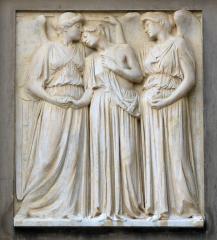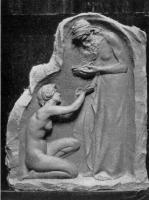 Immortality is the figure on the right.
Immortality is the figure on the right.
 Immortality is the figure on the right.
Immortality is the figure on the right.
The best known Victorian sculpture of Immortality is in Liverpool, on one of the panels on the side of St George’s Hall. The panel, with a typically long name, is entitled ‘Justice receives the kiss of Righteousness and the Crown of Immortality’, and is the work of the sculptor Thomas Stirling Lee. The figure of Immortality is the angel on the right hand side, with one hand lifted to hold the crown above Justice’s head – this crown can only just be discerned, as the low relief spiky bits have little demarcation from the backing panel. In Immortality’s other hand however is a recognisable eternal flame. Nevertheless, without the name, this figure could as easily have been some other allegorical statue, perhaps Truth or even Faith.
This next example is a simple, symmetrical angel, rather androgynous, holding a plaque labelled Immortality. The face is mature, of indeterminate age, not unreasonable for Immortality, but we are still left without a recognisable accoutrement – there is nothing so recognisable as Justice’s scales or Britannia’s shield.
Here we have a completely naked female figure, bereft of any implement, but she is leaning against a funereal cross, so she is a plausible depiction of the Immortal Soul, who by convention is normally nude (though in Victorian times the whole person complete with shroud is often shown moving heavenwards). The rocky base on which our figure sits may also be a symbol of enduring for ever. But again, we could imagine some different symbolism for her.
And in this last example we have something different again, being ‘The Mysterious Cup of Immortality’, a figure group by the sculptor Albert Toft. It is very well conceived, with the elderly male figure with his bony arm and sagging flesh contrasted with the lithe young female crouched in front of him, all soft, rounded forms and youthfulness; and a nice grouping with an asymmetrical triangular composition bound together by the surround, which gives an intimate feel to the group, and balanced, with the greater height of the standing man offset by the higher relief of the kneeling girl. But recognisable as Immortality? We do see the cup, more a bowl, in his hands, but we cannot even tell if he is to give it to her reaching hands, or if she has just passed it to him.
 Albert Toft's rendering of Immortality.
Albert Toft's rendering of Immortality.
We don’t seem then to have any pattern or convention to our statues representing Immortality, whether in the implements carried, or in the clothes or lack of them of the figure, or even the sex of the figure. Perhaps because there was generally more suitable iconography where a figure of Immortality might have done, whether that might be something Egyptian to indicate rebirth of the soul on a tomb, or a snake swallowing its tail, or an allegorical figure of Fame where the immortality of a name which would live forever was indicated.
Back to Allegorical sculpture - H // Onwards to Allegorical sculpture - J // Full Alphabet of Allegorical sculpture
Sculpture in London // Sculpture in England // Sculptors
Visits to this page from 20 Feb 2016: 4,834